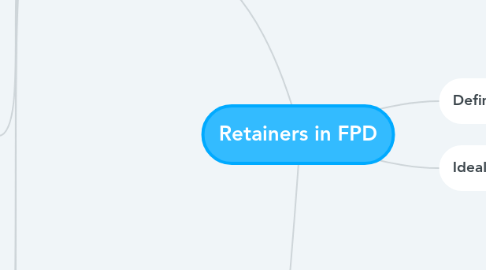
1. Classification
1.1. Based on tooth coverage
1.1.1. Full coverage retainer
1.1.1.1. Advantages
1.1.1.2. Disadvantages
1.1.1.3. Indications
1.1.1.4. Types
1.1.1.4.1. Full metal
1.1.1.4.2. Metal ceramic
1.1.1.4.3. All ceramic
1.1.1.4.4. All acrylic
1.1.2. Partial coverage retainer
1.1.2.1. Advantages
1.1.2.2. Disadvantages
1.1.2.3. Indications
1.1.2.4. Contraindications
1.1.2.5. Types
1.1.2.5.1. Posterior three quarter
1.1.2.5.2. Reversed three quarter
1.1.2.5.3. seventh eight
1.1.3. conservative retainer
1.1.3.1. Resin bonded retainer
1.1.4. Telescopic retainer
1.2. Based on location
1.2.1. Extra coronal
1.2.2. Intra coronal
1.2.2.1. Advantages
1.2.2.2. Disadvantages
1.2.2.3. Types
1.2.2.3.1. Inlay
1.2.2.3.2. Onlay
1.2.3. Intra radicular
1.2.3.1. Advantages
1.2.3.2. Disadvantages
1.2.3.3. Types of posts
1.2.3.3.1. Custom made
1.2.3.3.2. Prefabricated
1.3. Based on material being used
1.3.1. All metallic retainers
1.3.2. Non-metallic retainers
1.3.3. Resin bonded bridge retainers
1.3.4. Combined retainers
1.4. Based on mode of retention
1.4.1. Encircling the tooth
1.4.2. Mainly by grooves
1.4.3. Mainly by dowel pins
1.4.4. Post in the root canal
1.4.5. Conservative restorations

